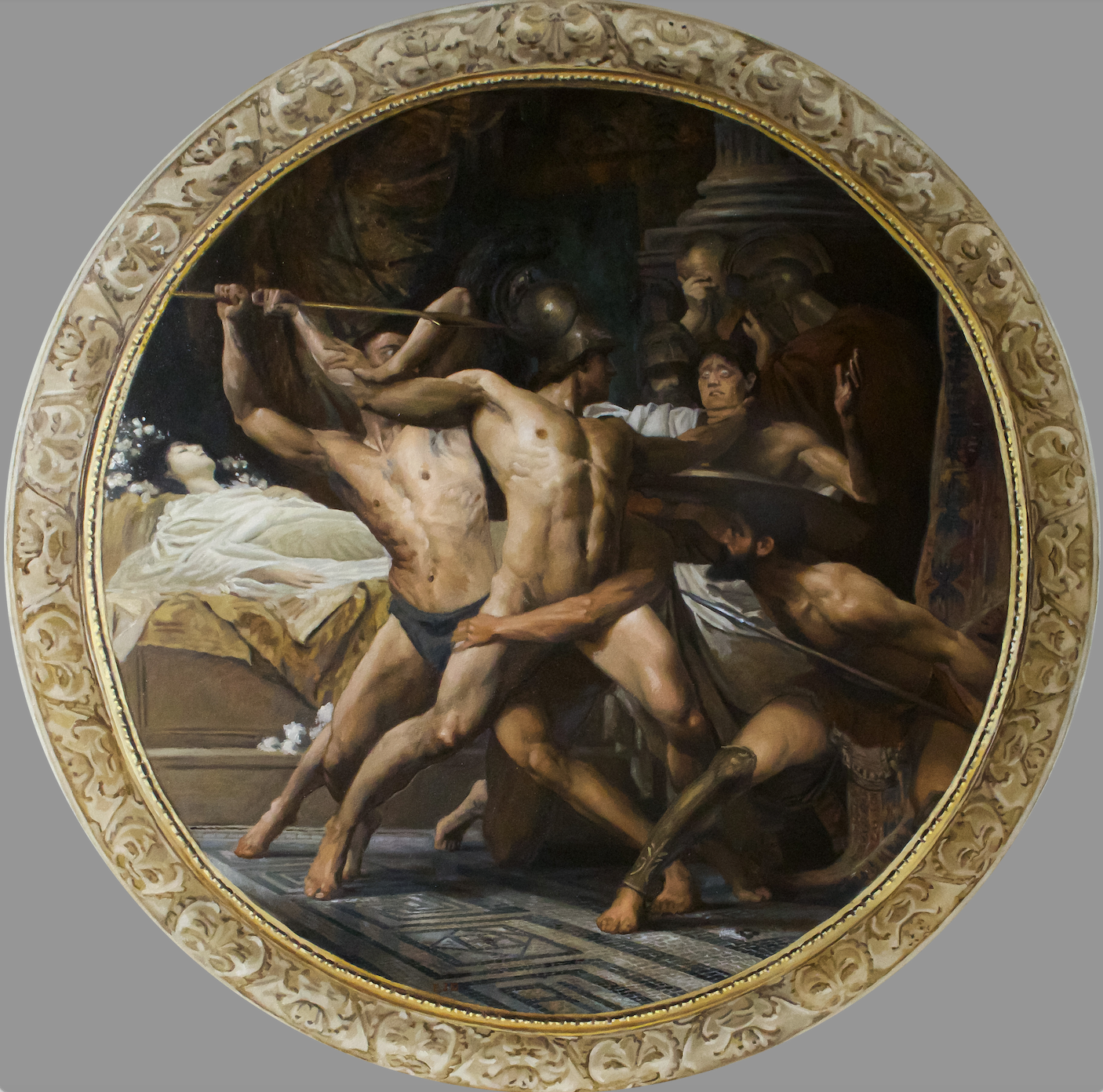 Image 1 of 1
Image 1 of 1


Achilles Discovers the Body of Patroclus
Artist: Eric Drummond, London, ON, Canada
Oil on Panel, 76 cm wide (tondo)
Eric’s depiction of the great turning point in Homers Iliad. Achilles is brought forth to see the body of his great friend, Patroclus. Erupting into rage, Achilles enters back into the battle, killing many Trojans and slays Hector, turning the tides of the war for the Greeks. While it is written in the Iliad that Achilles grieves with his mother, Eric chose to depict the moment of uncontrollable rage that erupts from his body when witnessing the corpse of his friend. In the painting, many Greeks attempt to restrain him as he lashes out to all in his proximity, but all attempts are ultimately futile. Eric’s concept revolved around how man in his limitations, when pushed, can become a force of nature. Achilles, here, is more than a man, but like a hurricane that the poor Greeks must wrestle. Compositionally, light is at its most contrasted within the figures actively fighting and engaging Achilles, symbolizing the duality of the conflict, while the figures in despair are cast into the background in melancholic shadow. Patroclus' body shines in white linens on the funerary slab, surrounded by flowers, to indicate the a transcendent serenity of no longer being a part of war. He is no longer a part of the crude and unforgiving world of man, that is by contrast exemplifying itself in the conflict in front of his body. While Achilles' body arches back, supremely primed to strike, his face in the darkness of rage; it is the figures in the background that truly reflect the grief and sadness that this Demi-God feels. This moment of eruption, this change from Achilles' neutrality to sudden desire for revenge, is a timely story that reminds us the value of our relationships and just how quick life can change at a moments notice, thus enforcing change (physical, psychological, emotional) on all of us.
Artist: Eric Drummond, London, ON, Canada
Oil on Panel, 76 cm wide (tondo)
Eric’s depiction of the great turning point in Homers Iliad. Achilles is brought forth to see the body of his great friend, Patroclus. Erupting into rage, Achilles enters back into the battle, killing many Trojans and slays Hector, turning the tides of the war for the Greeks. While it is written in the Iliad that Achilles grieves with his mother, Eric chose to depict the moment of uncontrollable rage that erupts from his body when witnessing the corpse of his friend. In the painting, many Greeks attempt to restrain him as he lashes out to all in his proximity, but all attempts are ultimately futile. Eric’s concept revolved around how man in his limitations, when pushed, can become a force of nature. Achilles, here, is more than a man, but like a hurricane that the poor Greeks must wrestle. Compositionally, light is at its most contrasted within the figures actively fighting and engaging Achilles, symbolizing the duality of the conflict, while the figures in despair are cast into the background in melancholic shadow. Patroclus' body shines in white linens on the funerary slab, surrounded by flowers, to indicate the a transcendent serenity of no longer being a part of war. He is no longer a part of the crude and unforgiving world of man, that is by contrast exemplifying itself in the conflict in front of his body. While Achilles' body arches back, supremely primed to strike, his face in the darkness of rage; it is the figures in the background that truly reflect the grief and sadness that this Demi-God feels. This moment of eruption, this change from Achilles' neutrality to sudden desire for revenge, is a timely story that reminds us the value of our relationships and just how quick life can change at a moments notice, thus enforcing change (physical, psychological, emotional) on all of us.